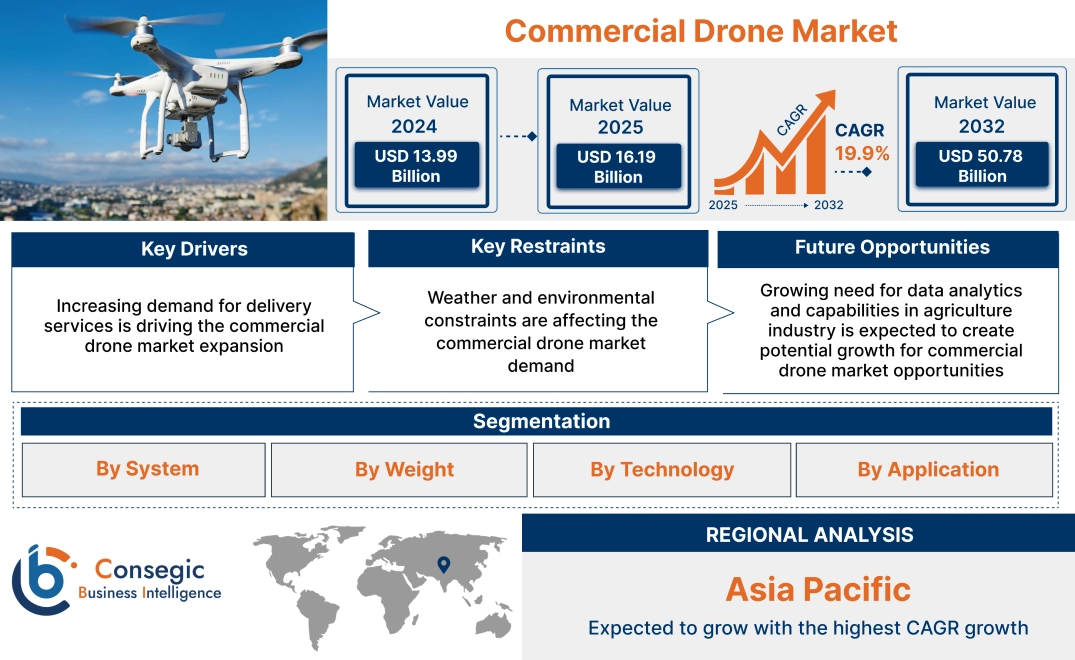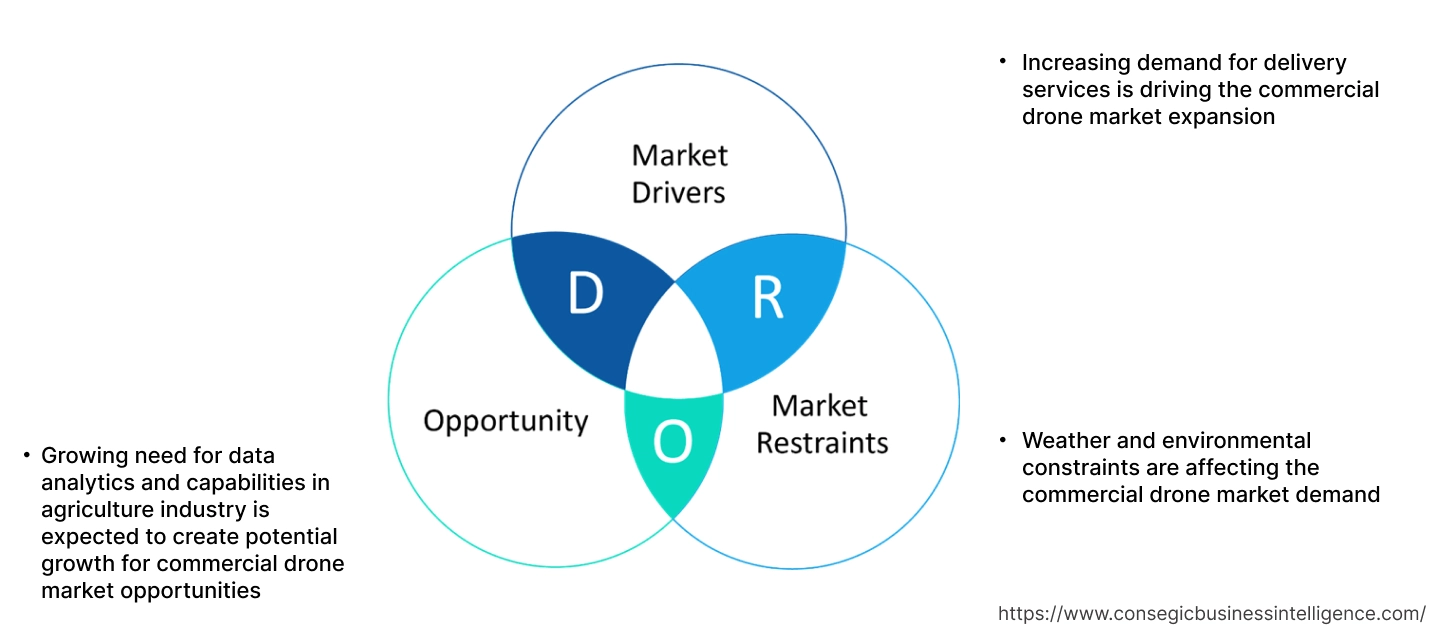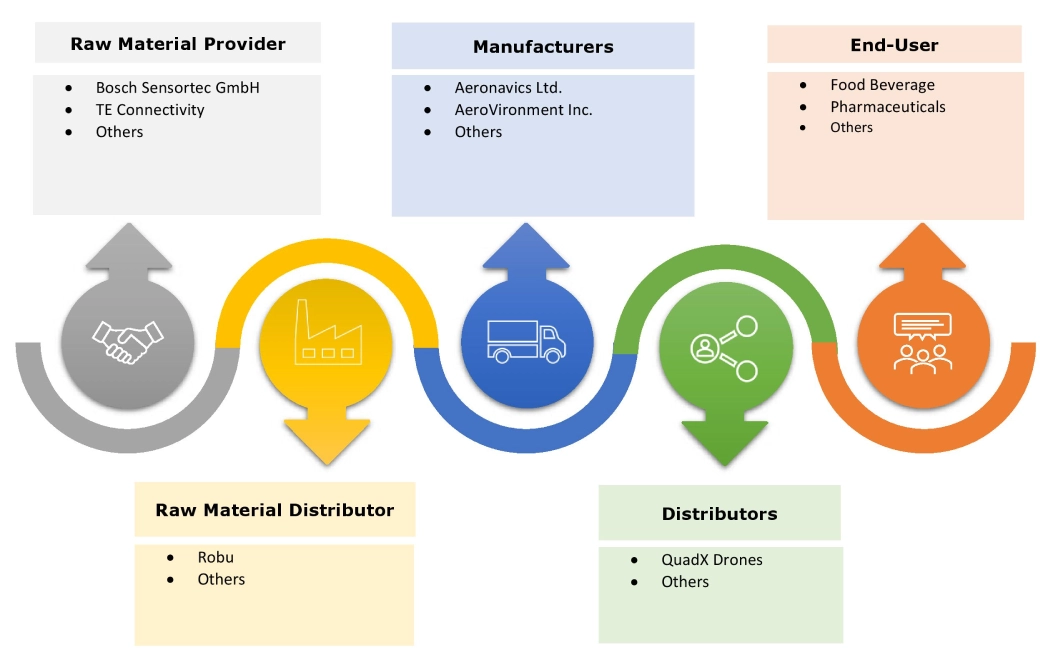- Summary
- Table Of Content
- Methodology
Commercial Drone Market Size:
Commercial Drone Market Size is estimated to reach over USD 50.78 Billion by 2032 from a value of USD 13.99 Billion in 2024 and is projected to grow by USD 16.19 Billion in 2025, growing at a CAGR of 19.9% from 2025 to 2032.
Commercial Drone Market Scope & Overview:
Commercial drone is an unmanned aerial vehicle (UAV), which is used for business or industrial purpose, such as data collection, inspections, and specialized services. Drones are reshaping the way businesses operate, offering capabilities in data acquisition, surveillance, and aerial inspection. By leveraging advanced sensors, cameras, and onboard computing systems, drones empower organizations to gather real-time intelligence, optimize resource allocation, and make informed decisions with superior speed and precision.
Key Drivers:
Increasing demand for delivery services is driving the commercial drone market expansion
The rise in e-commerce, coupled with evolving consumer preferences for faster and more convenient delivery options, has fueled the need for innovative solutions to address last-mile delivery challenges. Traditional delivery methods face limitations such as traffic congestion, delivery delays, and high operational costs, prompting businesses to explore alternative delivery solutions, including drones. Further, drones offer services and solutions to the last-mile delivery operations by providing faster, more flexible, and cost-effective means of transporting goods and packages to customers' doorsteps. With the ability to bypass traffic congestion and navigate through urban environments with ease, drones offer faster delivery times and enhanced customer satisfaction, particularly in densely populated areas where traditional delivery vehicles may struggle to reach.
- For instance, in October 2023, Amazon deployed its prime air drones, which will be used for the delivery of parcels for customers in the U.S. Further, the company has expanded its services to international locations, including U.K. and Italy.
Thus, according to the commercial drone market analysis, the growing adoption of drones for delivery services is driving the commercial drone market size.
Key Restraints:
Weather and environmental constraints are affecting the commercial drone market demand
Weather dependence can restrict the operational flexibility and responsiveness of UAVs, particularly in dynamic and rapidly changing environments. Drones, particularly those used for large-scale commercial applications, are often equipped with lightweight materials and are not designed to withstand harsh weather conditions. High winds affect the stability and control of drones, making it difficult to maintain precise direction of drones.
Moreover, the performance of GPS and sensors used for navigation can also be compromised in areas with poor satellite coverage or in dense urban environments. Thus, the aforementioned factors would further impact on the commercial drone market size.
Future Opportunities :
Growing need for data analytics and capabilities in agriculture industry is expected to create potential growth for commercial drone market opportunities
Enhanced data analytics capabilities represent a transformative prospect in agriculture, empowering farmers to extract valuable insights from the vast amounts of data generated by drones, sensors, and other digital technologies. By leveraging advanced analytics techniques such as machine learning, artificial intelligence, and predictive modeling, farmers can analyze complex datasets in real-time, uncovering patterns, trends, and correlations that inform decision-making and drive operational improvements.
Further, enhanced data analytics capabilities enable proactive risk management and decision support in agriculture, helping farmers anticipate and mitigate challenges such as pests, diseases, adverse weather events, and market fluctuations. By analyzing historical data, environmental conditions, and other relevant factors, farmers can identify patterns and trends that signal potential risks or opportunities and take preemptive action to minimize losses or capitalize on favorable conditions.
- For instance, in October 2022, DJI unveiled the Agras T40 drone, which was designed to streamline and accelerate crop spraying in fields, fruit trees, and orchards. The drone is equipped with advanced technology for precise and efficient application, which enhances operational activities for agriculture professionals.
Thus, based on the above commercial drone market analysis, the growing need for data analytics and capabilities in agriculture sector is expected to drive the commercial drone market opportunities.
Commercial Drone Market Segmental Analysis :
By System:
Based on system, the commercial drone market is segmented into hardware and software.
Trends in the system:
- The segment is expanding as drone technology enables companies to gather detailed insights that were previously difficult, costly, or dangerous to obtain. The ability to collect aerial data quickly and accurately is driving the need for drone-based solutions, offering new prospects for businesses to make data-driven decisions.
- The versatility, agility, and cost-effectiveness of drones make them attractive solutions for various industries seeking to enhance operational efficiency, data collection capabilities, and safety protocols. As a result, there is a growing prospects for manufacturers, service providers, and technology developers to capitalize on the expanding market for drone solutions tailored to specific requirements.
- Thus, the above factors are driving the commercial drone market demand.
The hardware segment accounted for the largest revenue share in the year 2024.
- With advancements in materials science and engineering, drone hardware continues to evolve, becoming more lightweight, durable, and capable of supporting advanced features such as extended flight times and higher payload capacities.
- Controller systems serve as the command and control interface for commercial drones, allowing operators to pilot and navigate the drone remotely. These systems include components such as flight controllers, navigation systems, and communication modules, which enable operators to monitor and control drone operations in real-time.
- Propulsion systems are designed to be efficient, reliable, and responsive, enabling drones to perform agile flight manoeuvres and carry payloads such as cameras, sensors, and other agricultural equipment for data collection and analysis.
- Thus, based on the above analysis, these factors are further driving the commercial drone market growth.
The software segment is anticipated to register the fastest CAGR during the forecast period.
- The software segment encompasses the programs and algorithms that control drone operations, manage data acquisition, and facilitate communication between the drone and its operators.
- As the need for customized and autonomous drone operations grows, software development plays a crucial role in enhancing drone capabilities, ensuring precision, reliability, and adaptability to various tasks and environments.
- For instance, in March 2025, Maxar Intelligence developed software, Raptor, a visual-based navigation technology, which enables UAV operations without depending on GPS. It provides terrain-based navigation system for drones in GPS-denied ecosystems, while utilizing 3D models for satellite imagery.
- Thus, based on the above analysis, these factors are expected to drive the commercial drone market share and growth during the forecast period.
By Weight:
Based on weight, the market is segmented into <2 Kg, 2 Kg - 25 kg, and 25 Kg - 150 Kg.
Trends in the weight:
- Rising adoption of drones with high payload capacity for transporting goods over long distances or delivering large-scale cargo, attributing to its long-duration flight capabilities, and robust payload capacities.
- The miniaturization of drones, increasing need for battery efficiency and communication systems are enhancing the capabilities of lighter and medium drones, making them more user friendly and effective.
The <2 Kg segment accounted for the largest revenue share in the year 2024.
- The less than 2 Kg segment is primarily driven by lightweight drones that are typically used for small-scale commercial applications, such as aerial photography, surveying, and package delivery.
- These drones offer enhanced portability, lower operational costs, and ease of use, making them popular among hobbyists and small business owners.
- For instance, in January 2025, DJI launched all-in-one vlog camera drone. With less than 249 grams, the compact drone features foldable coverage propeller guards, while ensuring ultra-safe and reliable flying process.
- Thus, based on the above analysis, these factors would further supplement the commercial drone market
The 2 Kg - 25 kg segment is anticipated to register the fastest CAGR during the forecast period.
- The 2 Kg - 25 Kg segment is expected to experience significant growth due to the rising demand for drones capable of handling heavier payloads for medium to large-scale commercial operations.
- These drones are commonly utilized in industries such as agriculture, infrastructure inspection, and logistics. They are designed to carry additional equipment like high-definition cameras, thermal sensors, and LiDAR systems, enabling precise data collection and real-time monitoring.
- Their ability to cover larger areas and operate in more complex environments makes them essential for businesses requiring increased efficiency and productivity.
- For instance, FIXAR-AERO LLC offers FIXAR 025, an autonomous drone that is designed to handle large-scale and long-range missions for industrial and commercial applications. The drone has the payload capacity of 10 kg, which features improved load maintenance and ease of utilization.
- These developments in the 2 Kg - 25 kg segment are anticipated to further drive the commercial drone market trends during the forecast period.
By Technology:
Based on technology, the commercial drone market is segmented into fully autonomous, semi-autonomous, and remote operated.
Trends in the technology:
- The integration of AI and cloud computing enables drone solutions to attain service accuracy and enhanced customer experience.
- Increasing adoption of smart commercial drones across industries is fuelling the market. Businesses are leveraging smart drones to gain actionable insights, improve productivity, and reduce costs in various operational areas.
The fully autonomous segment accounted for the largest revenue share of 48.61% in the year 2024.
- Fully autonomous drones can plan, execute, and adapt to missions dynamically based on real-time data and environmental inputs, enabling them to operate with minimal supervision or intervention from operators.
- These drones leverage advanced artificial intelligence (AI) algorithms, machine learning models, and sensor fusion techniques to perceive and respond to changes in the environment, navigate obstacles, and optimize mission performance in real-time.
- Fully autonomous drones enable farmers to automate repetitive tasks, optimize resource allocation, and improve decision-making in agriculture, leading to increased efficiency, productivity, and sustainability in farming operations.
- For instance, in February 2025, the Advanced Engineering School at Southern Federal University (SFedU) developed autonomous drones for precision agriculture application. The project includes robotics, AI, and agricultural science to develop effective solutions in precision farming.
- Thus, based on the above analysis, these factors are driving the commercial drone market growth.
The remote operated segment is anticipated to register the fastest CAGR during the forecast period.
- The proliferation of remote operated UAVs is driven by advancements in miniaturized sensor technology, improvements in flight autonomy and endurance, and the development of sophisticated data processing and analytics software.
- These drones fly at low altitudes, providing high-resolution imagery and detailed spatial information that are often inaccessible to satellites or manned aircraft.
- They offer rapid deployment and on-demand data collection capabilities, making them ideal for time-sensitive applications such as disaster response, emergency mapping, and environmental monitoring.
- For instance, in March 2025, Volatus Aersopace Inc. received an approval from Transport Canada, to conduct long distance remote operated drone operations at night. The drones will fly at airspace below 400 feet over low-density populations. This approval enables company to conduct critical operations, such as night-time facility, boarder surveillance, search and rescue, and thermal detection of wildfires.
- These factors are anticipated to further drive the commercial drone market trends during the forecast period.
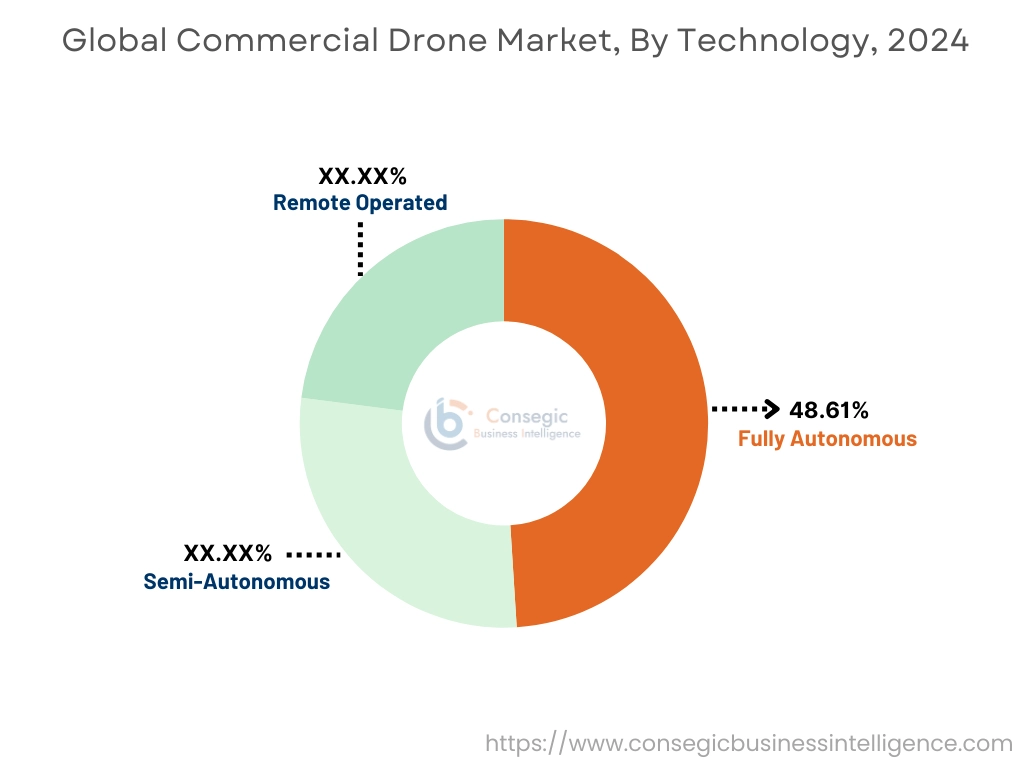
By Application:
Based on application, the commercial drone market is segmented into delivery and logistics, filming & photography, horticulture and agriculture, inspection and maintenance, mapping and surveying, surveillance & monitoring, and others.
Trends in the application:
- The growing trend toward digitization and automation in industries is driving the demand for drone analytics solutions. Organizations are leveraging drones and analytics software to streamline operations, enhance decision-making processes, and gain a competitive edge.
- With advancements in drone technology and regulatory frameworks, companies are exploring the use of drones for last-mile delivery in urban, rural, and remote areas, offering advanced shipping options and enhanced logistics efficiency.
The filming & photography segment accounted for the largest revenue share in the year 2024.
- Filming & photography stands as a prominent application within the market, where drones are utilized to capture aerial imagery and video footage for filmmaking, advertising, real estate marketing, and event coverage among others.
- The drones are equipped with high-resolution cameras and stabilized gimbal systems, which enable filmmakers and photographers to achieve dynamic perspectives, sweeping aerial shots, and immersive storytelling experiences.
- For instance, in May 2023, IBM announced the collaboration with Capgemini, to enhance their Drone-as-a-Service (DaaS) offerings. This partnership aims to provide complete solutions for monitoring and managing drone fleets, which can be utilized for various applications, including photography, filming, data capture, and inspections.
- Thus, based on the above factors, these developments in the filming & photography segment are driving the market trends.
The surveillance & monitoring segment is anticipated to register the fastest CAGR during the forecast period.
- Surveillance & monitoring represent critical applications in public safety and security, where drones play a pivotal role in enhancing situational awareness, reconnaissance, and emergency response capabilities.
- The drones are equipped with thermal imaging cameras, night vision sensors, and real-time video transmission systems.
- Drones enable law enforcement agencies, firefighting units, and search and rescue teams to conduct aerial surveillance, locate missing persons, and assess disaster-affected areas in a timely and efficient manner.
- For instance, in July 2024, the Lucknow Electricity Administration (LESA) deployed surveillance drones in their electricity grids and power plants, to deal with electricity thefts in high-line loss areas. The deployed drones are intended to monitor and carry out surveillance activities in narrow lines during the early morning hours.
- These factors are anticipated to further drive the global market during the forecast period.
Regional Analysis:
The global market has been classified by region into North America, Europe, Asia-Pacific, Middle East & Africa, and Latin America.
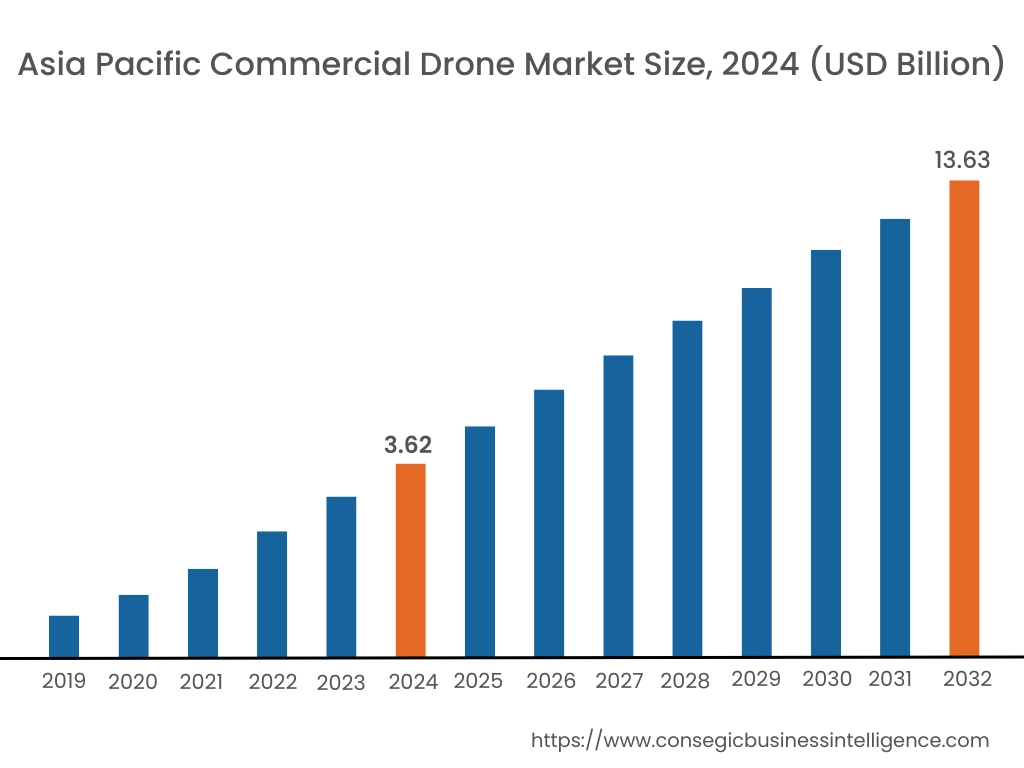
Asia Pacific commercial drone market expansion is estimated to reach over USD 13.63 billion by 2032 from a value of USD 3.62 billion in 2024 and is projected to grow by USD 4.20 billion in 2025. Out of this, the China market accounted for the maximum revenue split of 31.19%. Asia Pacific emerges as a region of immense potential for drones-powered solutions, propelled by the rapid expansion of renewable energy capacity and increasing investments in drone technology. Countries such as China, India, and Japan are witnessing significant deployments of drone solutions and services to support the development, construction, and operation of solar and wind energy installations. As Asia Pacific nations continue to transition towards cleaner and more sustainable energy sources, the demand for drone-based solutions for asset management, monitoring, and performance optimization is expected to grow, while presenting lucrative prospects for drone providers in the region. These factors would further drive the commercial drone market in the region during the forecast period.
- For instance, in February 2025, the Madhya Pradesh government in India approved the Drone Utilisation and Promotion 2025, which aims to advance drone manufacturing, assembly, and maintenance in the state. The policy included several incentives for the drone industry, which will be provided to businesses setting-up manufacturing plants in the state.
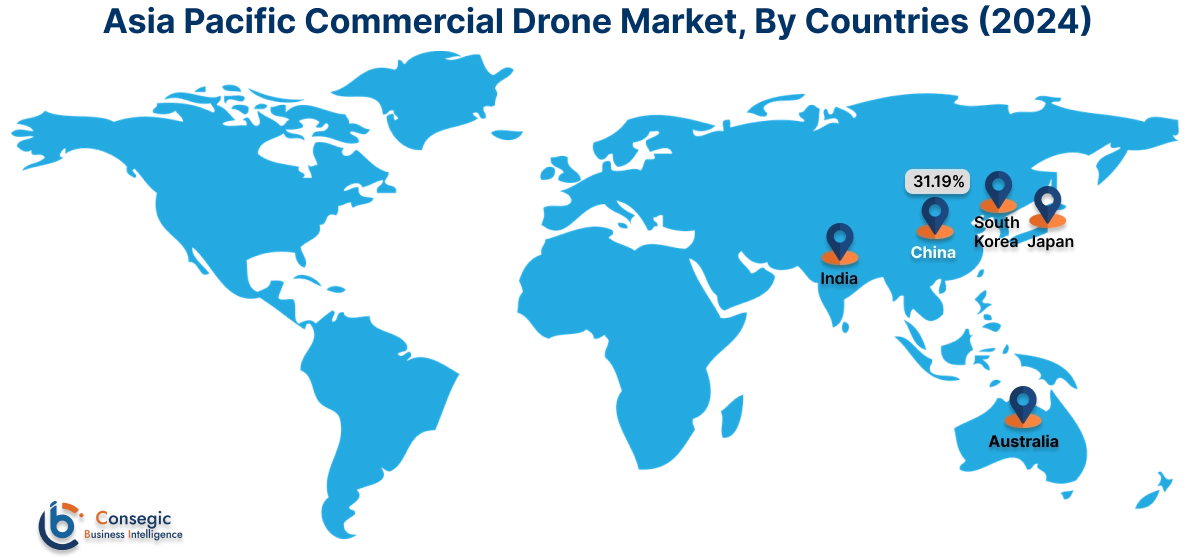
North America market is estimated to reach over USD 17.40 billion by 2032 from a value of USD 4.85 billion in 2024 and is projected to grow by USD 5.61 billion in 2025. The market in North America is driven due to the prevalence of advanced infrastructure and significant investments in drone services by business organizations. Moreover, the rising adoption of drones in sectors such as agriculture, real estate, and construction are further driving the market. In addition, North America's favorable regulatory environment for drone usage, with clear guidelines provided by authorities such as Federal Aviation Administration (FAA), has facilitated the development of drone-powered business solutions in the region. These factors would further drive the commercial drone sector in the regional market.
- For instance, in June 2024, Drone Delivery Canada (DDC) signed multiple commercial contracts valued at USD 417,000, for deployment of drones at Edmondon International Airport (YEG). The above factors are driving the market in North America.
Additionally, according to the analysis, the commercial drone industry in Europe is projected to witness significant development during the forecast period. Countries within the European Union prioritize renewable energy technologies and promote the adoption of solar-powered UAVs for various civilian and military applications. European defense contractors and research institutions collaborate on projects aimed at developing advanced UAV systems capable of addressing emerging security threats and environmental challenges. Additionally, the Latin American market growth is attributed to the rising utilization of drones in several applications, including mapping, surveying, and surveillance among others. Further, countries in the Middle East, such as the United Arab Emirates and Saudi Arabia, are investing heavily in renewable energy projects, including solar and wind farms, creating potential prospects for drone applications in site assessment, construction monitoring, and ongoing maintenance. Similarly, African nations are leveraging their vast renewable energy potential to drive economic development and energy access, with drones playing a pivotal role in optimizing resource utilization and operational efficiency.
Top Key Players and Market Share Insights:
The global commercial drone market is highly competitive with major players providing products to the national and international markets. Key players are adopting several strategies in research and development (R&D), product innovation, and end-user launches to hold a strong position in the market. Key players in the commercial drone industry include-
- Aeronavics Ltd. (New Zealand)
- AeroVironment Inc. (U.S.)
- Parrot Drones SAS (France)
- PrecisionHawk Inc. (U.S.)
- YUNEEC International (China)
- Autel Robotics (China)
- SZ DJI Technology Co Ltd (China)
- Draganfly Innovations Inc. (Canada)
- Guangzhou EHang Intelligent Technology Co. Ltd (China)
- Intel Corporation (U.S.)
Recent Industry Developments :
Product Launch:
- In February 2025, DJI launched DJI Dock 3, which is drone in a box solution that supports vehicle mounting, along with 24/7 remote operations for multiple environments. The new enterprise drones provide enhanced flight and protection performance.
Partnership & Collaboration:
- In February 2025, Advexure partnered with MatrixSpace for enhancing its drone operations and solutions. The partnership enables the integration of Advexure’s expertise in complex solution delivery with advanced AI-sensing radar technology from MatrixSpace. This partnership aims at improving the company’s drone capabilities for infrastructure, public safety, and utility customers among others.
Commercial Drone Market Report Insights :
| Report Attributes | Report Details |
| Study Timeline | 2019-2032 |
| Market Size in 2032 | USD 50.78 Billion |
| CAGR (2025-2032) | 19.9% |
| By System |
|
| By Weight |
|
| By Technology |
|
| By Application |
|
| By Region |
|
| Key Players |
|
| North America | U.S. Canada Mexico |
| Europe | U.K. Germany France Spain Italy Russia Benelux Rest of Europe |
| APAC | China South Korea Japan India Australia ASEAN Rest of Asia-Pacific |
| Middle East and Africa | GCC Turkey South Africa Rest of MEA |
| LATAM | Brazil Argentina Chile Rest of LATAM |
| Report Coverage |
|
Key Questions Answered in the Report
How big is the Commercial Drone Market? +
Commercial drone market size is estimated to reach over USD 50.78 Billion by 2032 from a value of USD 13.99 Billion in 2024 and is projected to grow by USD 16.19 Billion in 2025, growing at a CAGR of 19.9% from 2025 to 2032.
Which is the fastest-growing region in the Commercial Drone Market? +
Asia-Pacific is the region experiencing the most rapid growth in the market.
What specific segmentation details are covered in the Commercial Drone report? +
The commercial drone report includes specific segmentation details for system, weight, technology, application, and region.
Who are the major players in the Commercial Drone Market? +
The key participants in the market are Aeronavics Ltd. (New Zealand), AeroVironment Inc. (U.S.), Autel Robotics (China), SZ DJI Technology Co Ltd (China), Draganfly Innovations Inc. (Canada), Guangzhou EHang Intelligent Technology Co. Ltd (China), Intel Corporation (U.S.), Parrot Drones SAS (France), PrecisionHawk Inc. (U.S.), YUNEEC International (China), and others.
